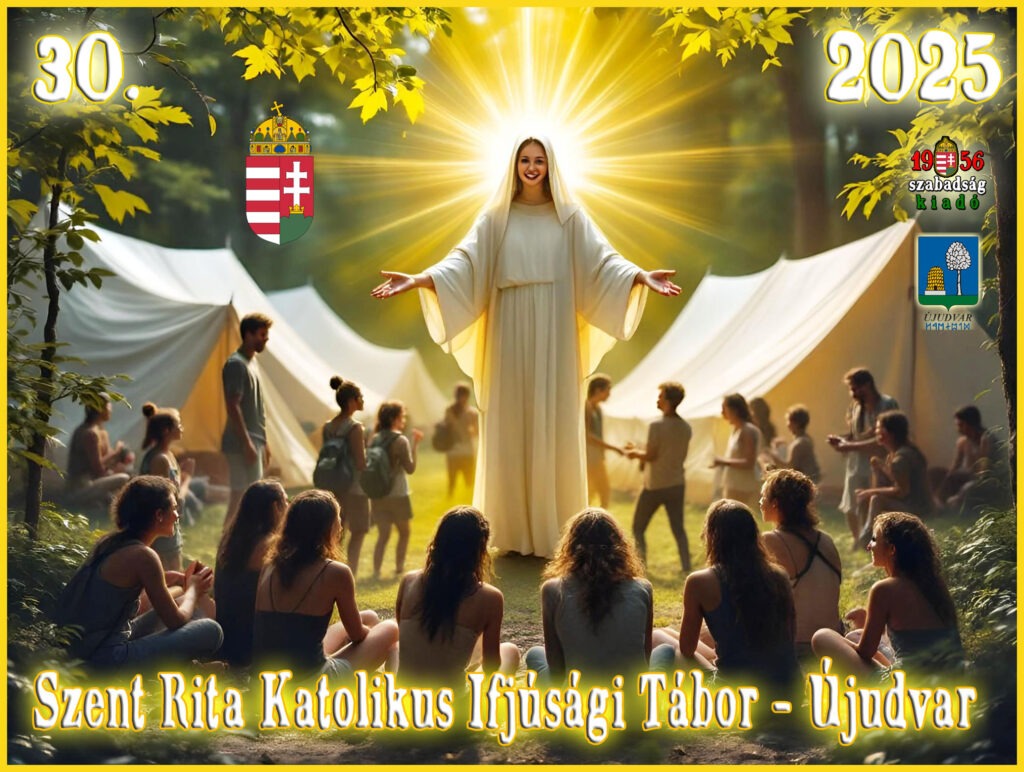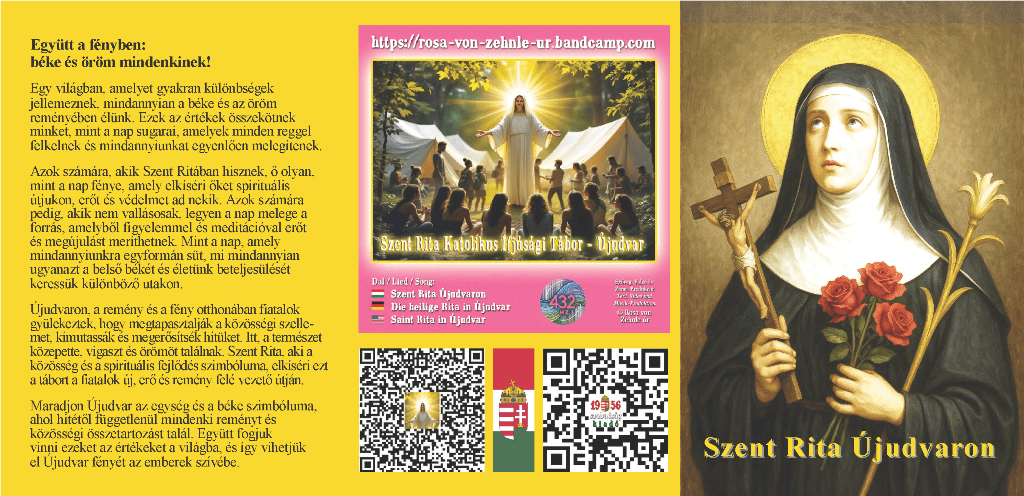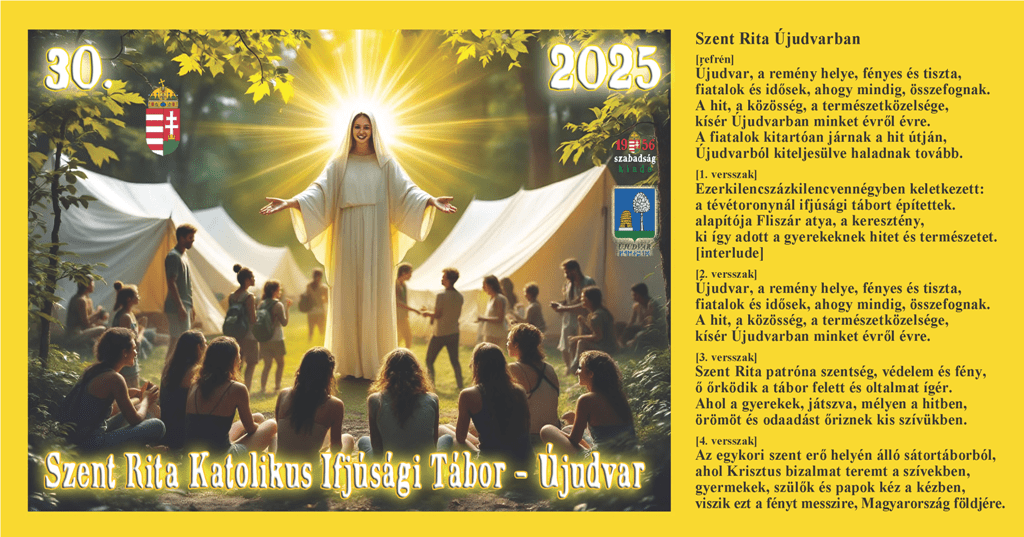🇭🇺 30 éves
a Szent Rita Katolikus
Ifjúsági Tábor
1994–2025:
Visszatekintés és kitekintés a megélt hitre, közösségre és természetre!

🇩🇪 30 Jahre
Szent Rita Katolikus
Ifjúsági Tábor
1994–2025:
Ein Rückblick und Ausblick auf gelebten Glauben, Gemeinschaft und Natur!
Cikkek angol nyelven / Artikel in Englisch / Articles in English
🇭🇺 A Bandcamp háromnyelvű dalához: »> itt …
🇭🇺 16 rövid változatban (1 perc) a YouTube-on
🇭🇺 Három nyelvű dalszöveghez: »> itt …
🇭🇺 Háromságos szentkép: HU és DE .…
🇩🇪 Dreisprachen-Lied auf Bandcamp: »> hier …
🇩🇪 16 Kurzfassungen (1 Minute) auf Youtube
🇩🇪 Zum Liedtext in drei Sprachen »> hier …
🇩🇪 Dreifaltiges Heiligenbild: HU und DE .…
🇭🇺 A kezdetek a rádiótorony alatt
1994 nyarán Fliszár Károly atya megalapította az újudvari katolikus ifjúsági tábort. Az ötlet az volt, hogy összehozza a gyerekeket és a fiatalokat egy olyan helyen, ahol közösségben élhetik meg hitüket, és első kézből tapasztalhatják meg a természetet. A tábor kezdete óta az újudvari tévétorony alatti tisztáson – az erdő szélének szimbolikus pontján – kerül megrendezésre.
Az alapító: Fliszár Károly
Atya 1950. augusztus 7‑én született Kaposfőn, 1975-ben szentelték pappá Veszprémben. A következő plébániákon szolgált lelkészként:
- 1981–93 Lad (és Hedrehely),
- 1993–99 Újudvar (kiegészítésként Gelsén, Homokkomáromban és Magyarszerdahelyen is szolgált),
- 1999–2015 Nagykanizsán,
- 2015–2019 Zalaszentbalázson.
Ezután további feladatokat is vállalt. *
1994-ben megalapította az első Szent Rita Ifjúsági Tábort közvetlenül a TV-torony lábánál – a kezdeményezés célja, hogy a fiatal keresztények számára természetes környezetet biztosítson a hit, a közösség és a kikapcsolódás számára.
A közösség nagyra értékelte elkötelezettségét: „sokat tett az egyházközösségért” – áll egy beszámolóban.
Újudvari szerepvállalását energikus
cselekvés jellemezte: megszervezte a tábort, kapcsolatokat épített ki a szponzorokkal, és látható hitvallást tett azzal, hogy annak a Szent Rita – a reménytelen gondok szentjének – nevét választotta. Életműve a 2015-ös távozása után is folytatódik, és tartós hatással van a táborra.
A résztvevők származási helye
a kereken 200 gyermek és fiatal főként a Kaposvári Egyházmegyéből, majd Zala és Somogy megyéből érkezik.
Ezenkívül az ország minden tájáról, alkalmanként külföldről is érkeznek résztvevők – például egy francia testvérpár is részt vett a 2024-es táborban.
Sok fiatal tér vissza évente, ami családias légkört teremt és kialakítja a táborhoz fűződő erős köteléket.
Családi nap kezdete
A tábor évek óta a Családi nappal kezdődik, ahol a szülők és a családtagok megismerkedhetnek a tábor területével, a csoportvezetőkkel és a többi gyerekkel. Ez a társasági interakció ünnepe – játékokkal, zenével, kulturális előadásokkal és spirituális megnyitóval.
Keresztény alapokon nyugvó tábori élet
A tábor két korosztálynak szól:
• 6–12 év (gyermektábor),
• 13–17 év (ifjúsági tábor).
Ezenkívül minden évben megrendezik a „Családi napot”, ahol a családok együtt merülhetnek el a tábori életben, és egy egész napon át átélhetik azt.
A hangsúly a következőkön van:
• Napi szentmise;
• Imádság és vallási beszélgetések;
• Tábori élet játékokkal, túrákkal és tábortüzekkel;
• Tanfolyamok, előadások és sporttevékenységek.
A tábor mindenki számára nyitott – még a nem hívők számára is –, és természetes módon közvetít olyan értékeket, mint a közösség, a felelősségvállalás és a hit.
Lemondások a koronavírus miatt
Sajnos a tábort két évre – 2020-ra és 2021-re – le kellett mondani a COVID-19 világjárvány miatt. Ez az éves rendezvénysorozat 2025-ben ünnepli 30. évfordulóját, bár 1994 óta már 32 év telt el.
Folytonosság és változás
A tábor e három évtized alatt folyamatosan fejlődött:
- Egy egyszerű sátortáborból strukturált hittáborrá vált;
- Helyi csoportok mellett több régióból érkező résztvevője van;
- A lelkész alapította tábort ma már elkötelezett világiak, papok és önkéntesek támogatják.
A változások ellenére a cél ugyanaz maradt: a fiatalok felhatalmazása – a hit, a természet és a közösség révén.
Távlatok
A 2025 júliusában megrendezésre kerülő 30. tábort a hálának, az emlékezésnek és az megörökítésnek szentelik. Egy időkapszulát terveznek – amely a táborozó család gondolatait, emlékeit és kívánságait tartalmazza –, hogy megőrizzék az élményeket a jövő generációi számára.
Távlatok: A hit kitart. Holnap is.
A Szent Rita Tábor három évtizede nemcsak ünneplési ok, hanem élénk hitkultúra jele is korunkban. Ami Újudvaron kezdődött, az több volt, mint egy nyaralási ötlet – olyan hellyé vált, ahol a gyerekek, fiatalok és családok erőt merítenek, barátságokat kötnek, és megtapasztalják Krisztus közelségét.
Újudvar ma már sokkal több, mint egy rádiótorony alatt megbúvó falu – a hit helye, amelyet nemcsak az évenként megrendezett Szent Rita Tábori hetek formálnak és tartanak fenn.
Előre tekintve reménykedhetünk. Bárcsak a következő generációk is ezen az úton haladnának – a szolidaritás, az elkötelezettség és Újudvar tartós hatása által megerősítve.
A 30. évfordulón résztvevők és érdeklődők számára megírtam a Szent Rita Újudvaron című dalt, amelynek több zenei változatát (lassúbb és gyorsabb stílusban is) készítettem el, és három nyelven mutatom be: magyarul, németül és angolul.
Szentháromság képe
Ehhez illően készítettem egy képet a Szentháromságról, és sok embernek szétosztottam a családi napon a táborban található 30. Szent Rita Katolikus Gyülekezetben.
🇭🇺 A Bandcamp háromnyelvű dalához: »> itt …
🇭🇺 16 rövid változatban (1 perc) a YouTube-on
🇭🇺 Három nyelvű dalszöveghez: »> itt …
🇭🇺 Háromságos szentkép: HU és DE .…
🇩🇪 Die Anfänge unter dem Funkturm
Im Sommer 1994 wurde das katholische Jugendzeltlager von Pater Károly Fliszár in Újudvar ins Leben gerufen. Die Idee: Kindern und Jugendlichen an einem Ort zu bringen, an dem sie in Gemeinschaft den Glauben leben und die Natur unmittelbar erleben können. Veranstaltungsort ist seit Anbeginn die Lichtung unter dem Fernsehturm von Újudvar – ein symbolträchtiger Ort am Waldrand.
Der Gründer: Pater Károly Fliszár
Geboren am 7. August 1950 in Kaposfő und er wurde 1975 in Veszprém zum Priester geweiht. Er diente als Pfarrer in folgenden Gemeinden:
- 1981–93 Lad (und zudem Hedrehely),
- 1993–99 Újudvar (er betreute zusätzlich Gelse, Homokkomárom und Magyarszerdahely),
- 1999–2015 Nagykanizsa,
- 2015–2019 Zalaszentbalázs.
Danach übernahm er weitere Aufgaben. *
1994 gründete er dort das erste Szent‑Rita‑Jugendlager
direkt am Fuß des Fernsehturms – eine Initiative mit dem Ziel, jungen Christen eine naturnahe Umgebung für Glaube, Gemeinschaft und Erholung zu bieten.
Sein Einsatz wurde von der Gemeinde geschätzt: „vieles hat er für die Kirchengemeinde getan“**, wie es in einem Bericht heißt.
Sein Engagement in Újudvar
war geprägt von tatkräftigem Handeln: Er organisierte das Lager, knüpfte Verbindungen zu Sponsoren und legte mit der Namenswahl zu Szent Rita – der Heiligen der hoffnungslosen Anliegen – ein sichtbares Glaubensbekenntnis. Auch nach seinem Weggang seit 2015 ist sein Lebenswerk fortlebend und prägt das Lager nachhaltig.
Herkunft der Teilnehmenden
Die rund 200 Kinder und Jugendlichen kommen hauptsächlich aus der Diözese Kaposvár, also meist aus den Komitaten Zala und Somogy.
Daneben gibt es Teilnehmer aus dem ganzen Land, gelegentlich sogar aus dem Ausland – 2024 etwa nahm ein französisches Geschwisterpaar teil.
Viele Jugendliche kehren jährlich zurück, was den familiären Charakter und die starke Bindung zum Lager unterstreicht.
Der Familientag als Auftakt
Seit vielen Jahren beginnt das Lager mit dem Familientag, an dem Eltern und Angehörige das Gelände, das Betreuer und die anderen Kinder kennenlernen können. Es ist ein Fest der Begegnung – mit Spielen, Musik, kulturellen Vorführungen und geistlichem Auftakt.
Lagerleben mit christlichem Fundament
Das Lager richtet sich an zwei Altersgruppen:
- 6–12 Jahre (Kinderlager),
- 13–17 Jahre (Jugendlager).
Hinzu kommt jährlich ein „Családi nap“ (Familientag), an dem Familien gemeinsam in das Lagerleben eintauchen und es einen ganzen Tag lang erleben können.
Im Mittelpunkt stehen:
- tägliche Heilige Messe;
- Gebet und religiöse Gespräche;
- Zeltlagerleben mit Spielen, Wanderungen, Lagerfeuer;
- Kurse, Vorträge und Sportangebote.
Das Lager ist offen für alle – auch für Nicht‑Gläubige – und vermittelt auf natürliche Weise Werte wie Gemeinschaft, Verantwortung und Glaube.
Ausfälle durch Corona
Zwei Jahre – 2020 und 2021 – mußte das Lager wegen der C19-Plandemie leider ausfallen. Dadurch feiert diese jährliche Veranstaltungsreihe 2025 sein 30. Jubiläum, obwohl seit 1994 bereits 32 Jahre vergangen sind.
Kontinuität und Wandel
Über drei Jahrzehnte hat sich das Lager immer weiter entwickelt:
- Vom einfachen Zeltlager zum strukturierten Glaubenslager;
- Von lokalen Gruppen zu Teilnehmern aus mehreren Regionen;
- Von einem Geistlichen gegründet – heute durch engagierte Laien, Priester und Freiwillige getragen.
Trotz Wandel bleibt das Ziel gleich: Jugend stärken – durch Glaube, Natur und Gemeinschaft.
Ausblick
Das 30. Lager im Juli 2025 steht im Zeichen der Dankbarkeit, Erinnerung und Weitergabe. Geplant ist eine Zeitkapsel – mit Gedanken, Erinnerungen und Wünschen der Lagerfamilie, die das Erlebte für kommende Generationen bewahrt.
Ausblick: Glaube trägt – auch morgen
Drei Jahrzehnte Szent Rita Lager sind nicht nur ein Grund zum Feiern, sondern ein Zeichen lebendiger Glaubenskultur inmitten unserer Zeit. Was in Újudvar begann, war mehr als eine Ferienidee – es wurde zu einem Ort, an dem Kinder, Jugendliche und Familien Kraft schöpfen, Freundschaften schließen und zu Christus Nähe erfahren.
Újudvar ist heute weit mehr als ein Dorf unter einem Funkturm – es ist ein Ort des Glaubens, der nicht nur durch die jährlichen Szent Rita Lagerwochen geprägt und getragen wird.
Mit dem Blick nach vorn dürfen wir hoffen.
Mögen auch die kommenden Generation diesen Weg weitergehen – gestärkt durch Verbundenheit, Bekenntnis und das bleibende Wirken von Újudvar.
Ich habe für alle Teilnehmer und allen Interessierten zum 30. Jubiläum das Lied Heilige Rita in Újudvar geschrieben und musikalisch in verschiedene Version (langsame und flottere Musikrichtungen) umgesetzt und das zudem in drei Sprachen realisiert: ungarisch, deutsch und englisch.
Dreifaltiges Heiligenbild
Dazu passend habe ich noch ein dreifaltiges Heiligenbild gestaltet und am Familientag zum 30. Szent Rita Katolikus Ifjúsági Tábor an viele verteilt.
🇩🇪 Dreisprachen-Lied auf Bandcamp: »> hier …
🇩🇪 16 Kurzfassungen (1 Minute) auf Youtube
🇩🇪 Zum Liedtext in drei Sprachen »> hier …
🇩🇪 Dreifaltiges Heiligenbild: HU und DE .…
* Szöveg és zene / Text und Musik: Rosa von Zehnle úr.
Rosa von Zehnle úr
Ùjudvar, 2025.07.13
https://1956-hirek.org/5429
https://175er-verlag.org/.recherchiert/archive/5429

Here begins the English version…
🇺🇸 30 Years of Szent Rita Katolikus Ifjúsági Tábor 1994–2025:
A reflection and outlook on lived faith, community, and nature!
🇺🇸 Tri-lingual Song on Bandcamp: »> here …
🇺🇸 My Song, 16 short versions (1 minute) on YouTube
🇺🇸 To the lyrics in three languages »> here …
🇺🇸 Three-part holy image: HU and DE .…
The Beginnings under the Radio Tower
In the summer of 1994, the Catholic youth camp was founded by Father Károly Fliszár in Újudvar. The idea was to bring children and youth to a place where they could live their faith in community and experience nature directly. Since its inception, the event has been held at the clearing under the TV tower of Újudvar—a symbolic place on the edge of the forest.
The Founder: Father Károly Fliszár
Born on August 7, 1950, in Kaposfő, he was ordained a priest in Veszprém in 1975. He served as a parish priest in the following communities:
- 1981–93 Lad (and also Hedrehely);
- 1993–99 Újudvar (he also looked after Gelse, Homokkomárom, and Magyarszerdahely);
- 1999–2015 Nagykanizsa;
- 2015–2019 Zalaszentbalázs.
Afterwards, he took on further tasks
In 1994, he founded the first Szent Rita Youth Camp directly at the foot of the TV tower—an initiative aimed at providing young Christians with a natural environment for faith, community, and recreation.
His commitment was appreciated by the community: „he did a lot for the parish community“, as stated in a report. His engagement in Újudvar was characterized by active action: he organized the camp, established connections with sponsors, and, with the choice of the name Szent Rita—the saint of hopeless causes—made a visible confession of faith. Even after his departure in 2015, his life’s work continues to shape the camp sustainably.
Origin of the Participants
The approximately 200 children and youth mainly come from the Diocese of Kaposvár, mostly from the counties of Zala and Somogy. In addition, there are participants from all over the country, occasionally even from abroad—in 2024, for example, a French sibling pair participated. Many young people return annually, which underscores the familial character and strong bond with the camp.
Family Day as the Kick-off
For many years, the camp has begun with Family Day, where parents and relatives can get to know the grounds, the supervisors, and the other children. It is a festival of encounters—with games, music, cultural performances, and a spiritual kick-off.
Camp Life with a Christian Foundation
The camp is aimed at two age groups:
- 6–12 years (children’s camp),
- 13–17 years (youth camp).
In addition, there is an annual „Family Day“
(Családi nap), where families can immerse themselves in camp life and experience it for a whole day. The focus is on:
- Daily Holy Mass;
- Prayer and religious discussions;
- Camp life with games, hikes, campfires;
- Courses, lectures, and sports activities.
The camp is open to all—including non-believers—and naturally conveys values such as community, responsibility, and faith.
Cancellations due to Corona
For two years—2020 and 2021—the camp had to be canceled due to the C19 plandemic. As a result, this annual event series is celebrating its 30th anniversary in 2025, even though 32 years have already passed since 1994.
Continuity and Change
Over three decades, the camp has continued to evolve:
- From a simple camping site to a structured faith camp;
- From local groups to participants from several regions;
- Founded by a clergyman—today carried by engaged laypeople, priests, and volunteers.
Despite changes, the goal remains the same: strengthening youth—through faith, nature, and community.
Outlook
The 30th camp in July 2025 will be marked by gratitude, remembrance, and passing on. A time capsule is planned—with thoughts, memories, and wishes from the camp family, preserving the experiences for future generations.
Outlook: Faith Carries—Also Tomorrow
Three decades of Szent Rita Camp are not only a reason to celebrate but a sign of living faith culture in our time. What began in Újudvar was more than a holiday idea—it became a place where children, youth, and families draw strength, make friendships, and experience closeness to Christ.
Újudvar is today much more than a village under a radio tower—it is a place of faith, shaped and carried not only by the annual Szent Rita camp weeks.
Looking ahead, we may hope. May the coming generations continue on this path—strengthened by connection, confession, and the lasting impact of Újudvar.
For the 30th anniversary, I have written the song Saint Rita in Újudvar for all participants and interested parties and musically implemented it in various versions (slower and faster musical styles) and realized it in three languages: Hungarian, German, and English.
Triune Holy Image
To go with it, I have also designed a triune holy image and distributed it to many on Family Day at the 30th Szent Rita Katolikus Ifjúsági Tábor.
🇺🇸 Tri-lingual Song on Bandcamp: »> here …
🇺🇸 My Song, 16 short versions (1 minute) on YouTube
🇺🇸 To the lyrics in three languages »> here …
🇺🇸 Three-part holy image: HU and DE .…
.

Views: 82
